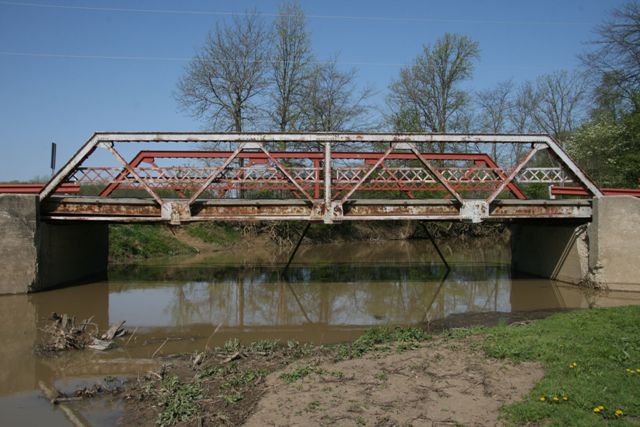We Recommend:
Bach Steel - Experts at historic truss bridge restoration.
Kniffen Race Track Road Bridge

Primary Photographer(s): Rick McOmber
Bridge Documented: May 3, 2008
Rural: Williams County, Ohio: United States
Not Available or Not Applicable
48.0 Feet (14.6 Meters)
54.0 Feet (16.5 Meters)
15.7 Feet (4.79 Meters)
1 Main Span(s)
8634475

View Information About HSR Ratings
Bridge Documentation
This bridge no longer exists!
View Archived National Bridge Inventory Report - Has Additional Details and Evaluation
This historic bridge was demolished and replaced by Williams County in 2010!
This bridge is a highly attractive pony truss with good historic integrity including original railings. The bridge trusses are painted red on the inside and white out the outside because apparently a budget paint job only had the time and money to repaint the interior of the trusses, and apparently red was the only available color. Either color looks attractive on the bridge, and a two color bridge is actually a nice change from the usual.
Despite the fact that this bridge could have been rehabilitated and preserved to carry the tiny amount of traffic it served, this bridge was demolished and replaced. The replacement bridge is a typical ugly box beam bridge which is basically a hollow slab of concrete with guiderail. A photo of the ribbon cutting ceremony showing the replacement bridge is shown below. By the way, these ribbon cutting ceremonies look a lot nicer with a preserved historic bridge in the background.
Photo Credit: Williams County Engineer
Information and Findings From Ohio's Historic Bridge InventorySetting/Context The bridge carries a 2 lane road over a stream in a rural area of active farms. Physical Description The 1 span, 54'-long, rivet-connected Warren pony truss bridge is traditionally composed of built-up members. It has lattice railings, concrete deck, and is supported on concrete abutments. Summary of Significance The 1920 Warren pony truss is a later example of its type/design with no distinguishing features. It has riveted connections, typical of Warren trusses from about 1900 to the 1940s when riveted connections began
to be phased out in favor of welded connections. The weld-connected Warren trusses continue to be a popular bridge type/design on county roads in Ohio. The survey has identified more than 500 pre-1961 Warren pony truss bridges,
making them the most common truss type/design surviving in the state. This example is not historically significant for its technology or context. More distinguished examples better represent the significance of the type/design in
the development of the state's road systems. The not eligible recommendation of the prior inventory remains appropriate. Bridge Considered Historic By Survey: No |
![]()
Photo Galleries and Videos: Kniffen Race Track Road Bridge
Bridge Photo-Documentation
Original / Full Size PhotosA collection of overview and detail photos. This gallery offers photos in the highest available resolution and file size in a touch-friendly popup viewer.
Alternatively, Browse Without Using Viewer
![]()
Bridge Photo-Documentation
Mobile Optimized PhotosA collection of overview and detail photos. This gallery features data-friendly, fast-loading photos in a touch-friendly popup viewer.
Alternatively, Browse Without Using Viewer
![]()
Maps and Links: Kniffen Race Track Road Bridge
This historic bridge has been demolished. This map is shown for reference purposes only.
Coordinates (Latitude, Longitude):
Search For Additional Bridge Listings:
Bridgehunter.com: View listed bridges within 0.5 miles (0.8 kilometers) of this bridge.
Bridgehunter.com: View listed bridges within 10 miles (16 kilometers) of this bridge.
Additional Maps:
Google Streetview (If Available)
GeoHack (Additional Links and Coordinates)
Apple Maps (Via DuckDuckGo Search)
Apple Maps (Apple devices only)
Android: Open Location In Your Map or GPS App
Flickr Gallery (Find Nearby Photos)
Wikimedia Commons (Find Nearby Photos)
Directions Via Sygic For Android
Directions Via Sygic For iOS and Android Dolphin Browser
USGS National Map (United States Only)
Historical USGS Topo Maps (United States Only)
Historic Aerials (United States Only)
CalTopo Maps (United States Only)


